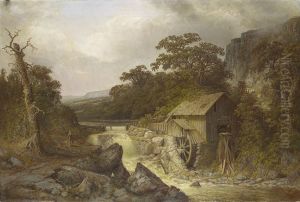Homer Watson Paintings
Homer Watson was a Canadian landscape painter born on January 14, 1855, in the village of Doon in the township of Waterloo County, now a part of Kitchener, Ontario. He was one of the earliest Canadian artists to gain international recognition for his work. Watson's artistic talent emerged early in his life, and he began his career as a self-taught artist, drawing inspiration from the rural landscapes surrounding his home.
Watson's style was heavily influenced by the European Romantic tradition, particularly the works of British artists John Constable and J.M.W. Turner. He was also aware of the American Hudson River School, which may have further influenced his approach to landscape painting. His paintings often depicted the Canadian wilderness, rural scenes, and dramatic natural events, such as storms and floods, with a focus on capturing the changing moods of nature.
Throughout his career, Watson achieved considerable success. His work 'The Pioneer Mill' won a first-class medal at the 1880 Royal Canadian Academy exhibition, and he later became a founding member of the Canadian Art Club in 1907. Watson's paintings were also exhibited internationally, including at the Paris Salon, where he received an honorable mention in 1881, and at the World's Columbian Exposition in Chicago in 1893.
Watson's influence extended beyond his artwork, as he was a strong advocate for Canadian art and artists. He sought to foster a distinct Canadian art movement, emphasizing the importance of the Canadian landscape as a subject for national artistic expression. Watson's home and studio in Doon became a meeting place for artists and an informal art school, further contributing to the cultural life of the region.
Homer Watson's legacy has been preserved in part by the Homer Watson House & Gallery, which was designated a National Historic Site of Canada in 1980. Watson continued to paint and contribute to the Canadian art scene until his death on May 30, 1936. His works can be found in various Canadian institutions, including the National Gallery of Canada, and continue to be celebrated for their contribution to the development of Canadian landscape painting.

